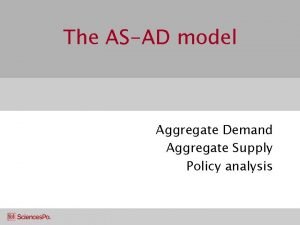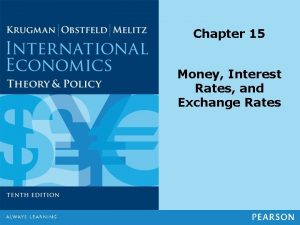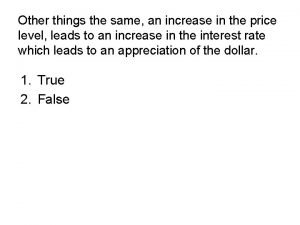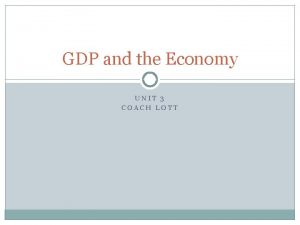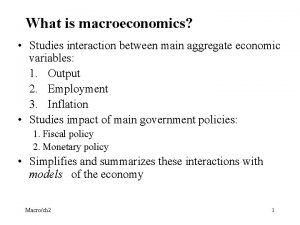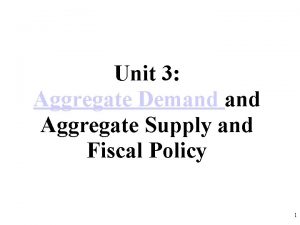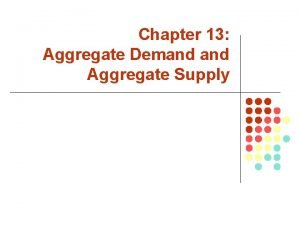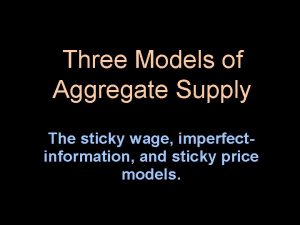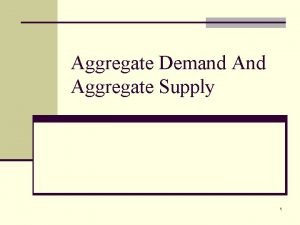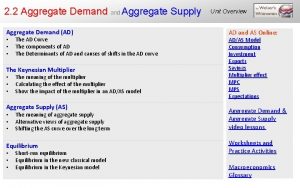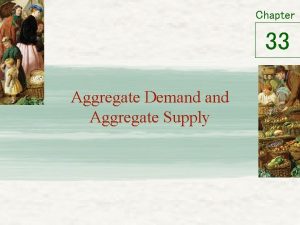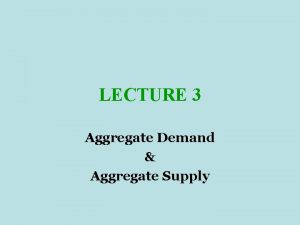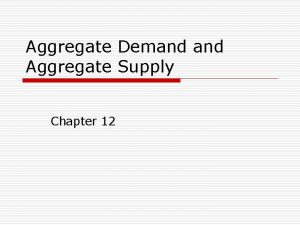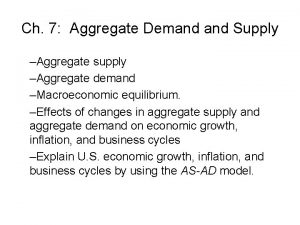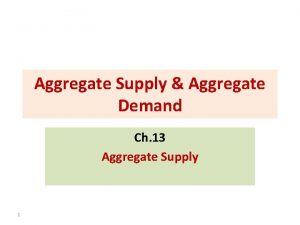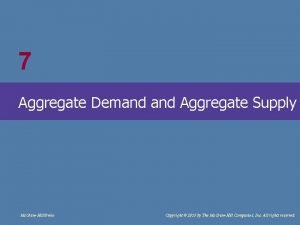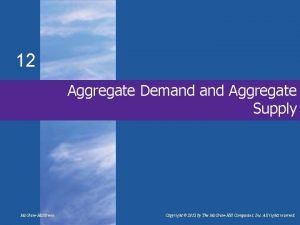32 Aggregate Demand Aggregate Supply Mc GrawHillIrwin Copyright



































- Slides: 35

32 Aggregate Demand Aggregate Supply Mc. Graw-Hill/Irwin Copyright © 2012 by The Mc. Graw-Hill Companies, Inc. All rights reserved.

Aggregate Demand Aggregate Supply • Learning objectives – After reading this chapter, students should be able to: • 1. Define aggregate demand (AD) and explain the factors that cause it to change. • 2. Define aggregate supply (AS) and explain the factors that cause it to change. • 3. Discuss how AD and AS determine an economy’s equilibrium price level and level of real GDP. • 4. Describe how the AD-AS model explains periods of demand -pull inflation, cost-push inflation, and recession. • 5. (Appendix) Identify how the aggregate demand curve relates to the aggregate expenditures model. LO 1

Aggregate Demand Aggregate Supply • AD-AS model is a variable price model. The aggregate expenditures model in Chapter 28 assumed constant price. • AD-AS model provides insights on inflation, unemployment and economic growth. LO 1

Aggregate Demand Aggregate Supply • Aggregate Demand • A schedule or curve that shows the various amounts of real domestic output that domestic and foreign buyers will desire to purchase at each possible price level. • The aggregate demand curve is shown in Figure 32. 1. • It shows an inverse relationship between price level and real domestic output. • The explanation of the inverse relationship is not the same as for demand for a single product, which centered on substitution and income effects. – a. Substitution effect doesn’t apply within the scope of domestically produced goods, since there is no substitute for “everything. ” LO 1

Price level Aggregate Demand AD 0 LO 1 Real domestic output, GDP

Aggregate Demand Aggregate Supply – Income effect also doesn’t apply in the aggregate case, since income now varies with aggregate output. • What is the explanation of the inverse relationship between price level and real output in aggregate demand? • a. Real balances effect: When price level falls, the purchasing power of existing financial balances (saving balances e. g. , deposits) rises, the public feels richer, which can increase spending and vice versa. • b. Interest‑rate effect: Given money supply, a decline in price level decreases the demand for money, which means lower interest rates that can increase levels of certain types of spending (C, Ig and Xn). A higher price level increases the demand for money, which means higher interest rates that can decrease spending. LO 1

Aggregate Demand Aggregate Supply • c. Foreign purchases effect: When price level falls, other things being equal, national prices will fall relative to foreign prices, which will tend to increase spending on national exports and also decrease import spending in favor of national. products that compete with imports. (Similar to the substitution effect. ), Xn increases, and vice versa. • Changes in aggregate demand: Determinants are the “other things” (besides price level) that can cause a shift or change in demand (see Figure 32. 2 in text). Effects of the following determinants are discussed in more detail in the text. • If one of those determinants changes, this directly changes AD. A multiplier effect produces a greater ultimate change in AD. LO 1

Price level Changes in Aggregate Demand AD 2 0 AD 3 AD 1 Real domestic output, GDP LO 1

Aggregate Demand Aggregate Supply • 1. Changes in consumer spending, which can be caused by changes in several factors. – – a. Consumer wealth b. Household borrowing c. Consumer expectations d. Personal taxes • 2. Changes in investment spending, which can be caused by changes in several factors. • a. Real interest rates • b. Expected returns, which are a function of – – LO 1 Expected future business conditions Technology Degree of excess capacity Business taxes

Aggregate Demand Aggregate Supply • 3. Changes in government spending. • 4. Changes in net export spending unrelated to price level, which may be caused by changes in other factors such as: – a. National income abroad, and – b. Exchange rates: For example, depreciation of the Brazilian real encourages Brazilian exports since Brazilian products become less expensive when foreign buyers can obtain more reals for their currency. Conversely, Brazilian real depreciation discourages import buying in Brazil because the reals can’t be exchanged for as much foreign currency. LO 1

Aggregate Demand Aggregate Supply • A schedule or curve showing the level of real domestic output available at each possible price level. • Aggregate supply in the immediate short-run (Figure 32. 3) • The aggregate supply curve is horizontal at a given price level due to the rigidity of prices • Aggregate supply in the short run (Figure 32. 4) • The short run aggregate supply curve is upward sloping. • The lag between product prices and resource prices makes it profitable for firms to increase output when the price level rises. LO 1

AS: Immediate Short Run Price level Immediate-short-run aggregate supply P 1 0 ASISR Qf Real domestic output, GDP LO 2

Aggregate Supply: Short Run AS Price level Aggregate supply (short run) 0 Qf Real domestic output, GDP LO 2

Aggregate Demand Aggregate Supply • To the left of full-employment output, the curve is relatively flat. The relative abundance of idle inputs means that firms can increase output without substantial increases in production costs. • To the right of full-employment output the curve is relatively steep. Shortages of inputs and production bottlenecks will require substantially higher prices to induce firms to produce. • Aggregate supply in the long run (Figure 32. 5) • In the long run the aggregate supply curve is vertical at the economy’s full-employment output. • The curve is vertical because in the long run resources prices adjust to changes in the price level, leaving no incentive for firms to change their output. LO 1

Aggregate Supply: Long Run Price level ASLR Long-run aggregate supply 0 Qf Real domestic output, GDP LO 2

Aggregate Demand Aggregate Supply • References to “aggregate supply” in the remainder of the chapter apply to the short run curve unless otherwise noted. • Changes in aggregate supply: Determinants are the “other things” besides price level that cause changes or shifts in aggregate supply (see Figure 32. 6 in text). The following determinants are discussed in more detail in the text. • 1. A change in input prices, which can be caused by changes in several factors. – a. Domestic resource prices – b. Prices of imported resources LO 1

Changes in Aggregate Supply AS 3 AS 1 Price level AS 2 0 Real domestic output, GDP LO 2

Aggregate Demand Aggregate Supply • 2. Changes in productivity (productivity = real output / input) can cause changes in per-unit production cost (production cost per unit = total input cost / units of output). If productivity rises, unit production costs will fall. This can shift aggregate supply to the right and lower prices. The reverse is true when productivity falls. Productivity improvement is very important in business efforts to reduce costs. • 3. Change in legal‑institutional environment, which can be caused by changes in other factors. – a. Business taxes and/or subsidies, and – b. Government regulation. LO 1

Aggregate Demand Aggregate Supply • IV. Equilibrium and Changes in Equilibrium • Equilibrium price and quantity are found where the aggregate demand supply curves intersect. (See Key Graph 32. 7 for illustration of why quantity will seek equilibrium where curves intersect. ) • Increases in aggregate demand cause demand-pull inflation (Figure 32. 8). • Increases in aggregate demand increase real output and create upward pressure on prices, especially when the economy operates at or above its full employment level of output. LO 1

Price level (index numbers) Equilibrium AS 100 a 92 b AD 0 502 510 514 Real domestic output, GDP (billions of dollars) LO 3 Real Output Demanded (Billions) Price Level (Index Number) Real Output Supplied (Billions) $506 108 $513 508 104 512 510 100 512 96 507 514 92 502

Increases in AD: Demand-Pull Inflation Price level AS P 2 P 1 AD 2 AD 1 0 Qf Q 1 Q 2 Real domestic output, GDP LO 4

Aggregate Demand Aggregate Supply • The multiplier effect weakens the further right the aggregate demand curve moves along the aggregate supply curve. More of the increase in spending is absorbed into price increases instead of generating greater real output. • Decreases in AD: If AD decreases, recession and cyclical unemployment may result. See Figure 32. 9. Prices don’t fall easily. 1. Fear of price wars keeps prices from being reduced. 2. Menu costs discourage repeated price changes. 3. Wage contracts are not flexible so businesses can’t afford to reduce prices. LO 1

Decreases in AD: Recession Price level AS P 1 P 2 b a c AD 1 AD 2 0 Q 1 Q 2 Qf Real domestic output, GDP LO 4

Aggregate Demand Aggregate Supply 4. Employers are reluctant to cut wages because of impact on employee effort, etc. Employers seek to pay efficiency wages – wages that maximize work effort and productivity, minimizing cost. 5. Minimum wage laws keep wages above that level LO 1

Aggregate Demand Aggregate Supply • CONSIDER THIS … Ratchet Effect • Shifting aggregate supply occurs when a supply determinant changes. • 1. Leftward shift in curve illustrates cost‑push inflation (see Figure 32. 10). • 2. Rightward shift in curve will cause a decline in price level (see Figure 32. 11). See text for discussion of this desirable outcome. • 3. In the late 1990 s, despite strong increases in aggregate demand, prices remained relatively stable (low inflation) as aggregate supply shifted right (productivity gains). LO 1

Decreases in AS: Cost-Push Inflation Price level AS 2 P 1 AS 1 b a AD 0 Q 1 Qf Real domestic output, GDP LO 4

Increases in AS: Full-Employment Price level AS 1 P 3 P 2 P 1 AS 2 b a c AD 2 AD 1 0 Q 1 Q 2 Q 3 Real domestic output, GDP LO 4

Aggregate Demand Aggregate Supply • LAST WORD: Has the Impact of Oil Prices Diminished? • In the mid- and late 1970 s, oil price shocks caused cost-push inflation, rising unemployment, and a negative GDP gap (stagflation). • In the late 1980 s and through most of the 1990 s, oil prices fell, prompting OPEC (along with Mexico, Norway, and Russia) to restrict output and raise prices (up to $34 per barrel in March 2000). This price shock did not cause the cost-push inflation and recessionary conditions as with previous shocks. • In 2005, conflict in the Middle East, combined with rapidly rising demand for oil in India and China, pushed oil prices above $60 per barrel (and over $70 per barrel in July 2006). U. S. inflation rose in 2005, but not core inflation (inflation rate minus price changes in food and energy). LO 1

Aggregate Demand Aggregate Supply • In 2007 oil prices again increased to $50 per barrel and in July of 2008 prices increased to $140 per barrel, but inflation didn’t occur. • A number of reasons explain why oil price shocks have had less of an impact: • 1. Oil prices are less significant in the U. S. economy today than in the 1970 s. • 2. The amount of gas and oil used to produce each dollar of output has declined by about 50 percent since 1970. (from 14, 000 BTUs to 7, 000 BTUs per dollar of GDP). • 3. A reallocation of production from larger, heavier energy intensive items to make toward smaller, lighter goods. • 4. Federal reserve monetary policy helped keep oil price increases from becoming generalized. LO 1

Derivation of Aggregate Demand • In Figure 1 we are deriving the aggregate demand curve from the aggregate expenditures model. Both models measure real GDP on the horizontal axis. • Suppose the initial price level is P 1 and aggregate expenditures is AE 1. Equilibrium real domestic output is Q 1. There will be a corresponding point on the aggregate demand curve (Point 1 ). • If price rises to P 2, aggregate expenditures will fall to AE 2 because purchasing power of wealth falls, interest rates may rise, and net exports fall. Then new equilibrium is at Q 2. That generates a point (Point 2 ) up and to the left of Point 1. LO 1

Derivation of Aggregate Demand • If price rises to P 3, real asset balance value falls, interest rates rise again, net exports fall and new equilibrium is at Q 3. This generates a point (Point 3 ). • Technically, the aggregate demand curve is found by drawing a line (or curve) through Points 1 , 2 , and 3. LO 1

Derivation of Aggregate Demand Aggregate Expenditures (billions of dollars) 1 2 3 LO 1 45° Price Level AE 1 (at P 1 ) AE 2 (at P 2 ) AE 3 (at P 3 ) 3 P 3 2 P 2 1 AD P 1 Q 3 LO 5 Q 2 Q 1 Real Domestic Product, GDP

Aggregate Demand Shifts • LO 1 Figure 2 shows shifts of the aggregate expenditures schedule and of the aggregate demand curve. When there is a change in one of the determinants of consumption, investment, or net exports, there will be a change in the aggregate expenditures as well. The change in aggregate expenditures is multiplied and aggregate demand shifts by more than the initial change in spending. The text illustrates the multiplier effect of a change in investment spending. Shift of AD curve = initial change in spending x multiplier.

Aggregate Demand Shifts AE 2 (at P 1 ) AE 1 (at P 1 ) P 1 AD 2 AD 1 Q 1 LO 5 Q 2

Aggregate Demand Aggregate Supply LO 1
 Aggregate supply shifters
Aggregate supply shifters Unit 3 aggregate demand aggregate supply and fiscal policy
Unit 3 aggregate demand aggregate supply and fiscal policy Sras lras
Sras lras Unit 3 aggregate demand aggregate supply and fiscal policy
Unit 3 aggregate demand aggregate supply and fiscal policy How to calculate aggregate demand
How to calculate aggregate demand Aggregate supply shocks
Aggregate supply shocks Aggregate demand supply graph
Aggregate demand supply graph Disaggregating the aggregate plan
Disaggregating the aggregate plan Aggregate demand supply graph
Aggregate demand supply graph Module 5 supply and demand introduction and demand
Module 5 supply and demand introduction and demand Matching supply and demand in supply chain
Matching supply and demand in supply chain Cannot mix aggregate and non aggregate tableau
Cannot mix aggregate and non aggregate tableau Aggregate demand curve
Aggregate demand curve Supply side shock
Supply side shock The aggregate real money demand schedule l(r,y)
The aggregate real money demand schedule l(r,y) Which of the following shifts aggregate demand to the left?
Which of the following shifts aggregate demand to the left? Aggregate demand curve
Aggregate demand curve Dad-das model
Dad-das model Contractionary monetary policy graph
Contractionary monetary policy graph Recessionary gap aggregate demand
Recessionary gap aggregate demand What is nominal gdp
What is nominal gdp Shifters of aggregate supply rap
Shifters of aggregate supply rap The aggregate real money demand schedule l(r,y)
The aggregate real money demand schedule l(r,y) Which aggregate supply curve has a positive slope
Which aggregate supply curve has a positive slope Supply curve shift to the left
Supply curve shift to the left Aggregate supply shifters
Aggregate supply shifters Sticky wage model
Sticky wage model Aggregate supply curve
Aggregate supply curve Aggregate planning solved examples
Aggregate planning solved examples Market demand curve
Market demand curve Methods of demand estimation
Methods of demand estimation Stochastic inventory model example
Stochastic inventory model example Independent and dependent inventory
Independent and dependent inventory Paradox of value
Paradox of value Demand schedule halimbawa
Demand schedule halimbawa Dependent and independent demand in inventory management
Dependent and independent demand in inventory management













